E11 hiking trail
The E11 Hiking Trail is a 2,560 km hiking trail in Europe through the Netherlands, Germany and Poland. It is one of the eleven footpaths coordinated by the European Ramblers Organization (ERA), also known as (German) Europäische Wandervereinigung (EWV) and (French) Féderation Européenne de la Randonnée Pédestre (FERP).
- This article is an itinerary.

The day-to-day management of the trail, from marking to re-routing, is performed by the Dutch national ramblers organization Wandelnet, a quango and umbrella organisation of Dutch rambling clubs, some German regional ramblers organizations and the Polish national hiking organization PTTK. In the Netherlands and western Germany, E11 follows regional footpaths (mostly unfit for other means of transport); east of the Harz mountains, E11 was designed after the fall of the Iron Curtain, and can also be covered by bicycle; and in Poland E11 is an amalgam of smaller and larger parts of local and regional trails which one could follow on foot or saddle.
Apart from the Harz mountains, E11 passes through flat or rolling land only. Many parts are covered with forest or at least commercial wood, but open agrarian and unused land is there. Western Germany is crossed on a range of low hills, which came into existence during the last Ice Age, about 12,000 years ago. After the Harz mountains, hardly any elevation is noticed. E11 often follows waterways for some time, crossing them with a ferry or a bridge, and at times lakes must be surrounded, for example in Masuria in Poland. Among the rivers followed and crossed are the IJssel in the Netherlands, the Elbe and Havel in Germany, the Oder or Odra on the border of Germany and Poland, and the Vistula (Wisła) in Poland.
Understand
E11 originated in 1980 from a string of short German paths as an international trail between the sister cities of Haarlem in the Netherlands and Osnabrück in Germany and was immediately extended to the Harz mountains. After the fall of the Iron Curtain, E11 became one of many means to stimulate the integration of Western and formerly Eastern, now Central Europe. This is why it was prolonged in the 1990s to Berlin and then into Poland. As the congestion around Amsterdam made it impossible to keep up a pleasant routing from Haarlem, the start was moved to Scheveningen. At the regional international level, Euregio began to exploit the stretch between Deventer in the Netherlands and Osnabrück in Germany in a commercial way, hoping to underpin its efforts to bring the populations on both sides of the international border closer together.
Ethnic and historical differences are noticeable along the track. The openness of the landscape of Western Netherlands (Holland), the rich agriculture more to the East, the landmarks of large Prussian estates and their endless fields, maintained or revived during the GDR, and the scars that centuries of German-Polish conflict and German and Soviet suppression drew - they are all visible along E11. This is corroborated by the fact that the Polish part of E11 is mostly in territories that were German until 1918 or even 1945. To enjoy your march along E11 more, you may read the encyclopaedic article about E11 European long-distance path in Wikipedia, where you'll also find hundreds of links to the townships along E11.
Prepare
E11 requires no preparation beyond the norm for long-distance hiking (see Hiking and the "Prepare" section of Appalachian Trail). Make sure you're in good physical condition, and have good equipment (don't go for cheap walking boots or a cheap backpack) and a good set of maps. Also make sure you have enough food and water to sustain yourself.
In parts of Poland the distances between places where one can sleep in a bed (rather than a tent) may be up to 35 km. If you don't feel like marching such distances (or even more if you lose your way), then carry a tent and sleeping bag. Be prepared for rain (and snow in winter) and wear fast-drying clothes if you plan to wash them during your trip.
With the help of the website of the German railway company DB it is easy to divide E11 into sections that are feasible in a single holiday trip of two or three weeks. Apart from The Hague, Bad Bentheim, Osnabrück, Hannover, Halle (Saale), Berlin, Frankfurt (Oder), Poznań, Toruń and Olsztyn are cities from which one may easily get away by train. Hannover, Berlin and Poznań also offer air services.
Once you have determined the E11 sections you'll walk, see to it that you acquire all the maps recommended below for that stretch. This will take a couple of weeks, if not months, since not all shops and publishers respond quickly.
In the Netherlands and Western Germany you will normally be understood if you communicate in English, but take basic vocabularies in German and Polish with you if you go further East. It helps if you learn to pronounce names and other words in the Dutch, German, Polish way, because an outspoken Anglophone accent is a severe handicap when you want to find your way or are hungry.
Stay safe
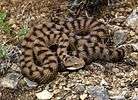
The biggest danger along E11 is hardly visible: the tick. The danger is not so much in this tiny animal itself, although its bite might occasionally cause an infection. The danger is in the parasites it may carry. Along the whole track, ticks are known to be infected (sometimes up to high percentages) with Lyme disease. East of the Harz mountains they may also carry tick-borne meningoencephalitis. You should carefully read the corresponding articles in Wikipedia or elsewhere, and get your vaccinations against tick-borne meningo-encephalitis before you venture into the Harz area or further east. There is no prophylaxis against Lyme disease, but it can be cured with antibiotics if caught early.
Apart from the occasional encounter with an adder, a boar, a pack of wolves or even a lynx, or a bite from any rabies-infected mammal, the path is otherwise perfectly safe and may even be followed in winter, provided one is adequately dressed and carries enough food and (hot) drinks. The Polish winter is long and cold! If you don't carry a tent, make sure that you can cover distances of 35 km as lodgings (and bus stops!) are sometimes scarce in Poland.
Get in
The start of E11 in Scheveningen is easily reached from all corners of the world: fly to Schiphol, the airport of Amsterdam, take one of the very frequent trains to "Den Haag CS", one of the railway stations of The Hague, and tramway 9 will bring you to the Kurhaus at the square of "Gevers Deynootplein". It is also possible to take an international train from Belgium or France to Rotterdam and change trains there for Den Haag CS. International trains from Germany offer a connection to Den Haag CS with a change of trains in Utrecht or Amersfoort. Coming from England, one would normally arrive by fast ferry from Harwich to the Hook of Holland and then follow the white-red marked European Coast Path E9 to Scheveningen.
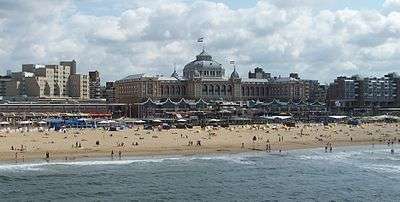
Ramblers starting from the UK and Ireland, who want to reach the start of E11 on foot, should make sure that they reach Harwich along the Essex Way, from where they should take the ferry to Hook of Holland and then follow E9 as mentioned above. It is also possible to reach Scheveningen by the same E9 from the South of England, North-western France and the Belgian coast. Another possibility to reach the Hook of Holland on foot is by E2 (also known as GR 5) from Nice, the East of France and almost all of Belgium.
By the way, the Gevers Deynootplein in front of the Kurhaus is not the kind of place where you park your car whilst rambling the 2,500 km of E11. Even if you manage to find a free parking space, you will have to pay several Euros an hour.
Walk
With the exception of the article you are now reading, the precise routing of E11 is not at all documented in the English language. If you are fluent enough in Dutch and German, you will reach the Harz mountains without problems, but in Eastern Germany and Poland even detailed sources in the local languages (German and Polish) are hard to find. For this article we obtained and translated a German out-of-print book, and flyers and other documents from offices of rambling organizations in Kassel, Prague, Poznan, Torun and Olsztyn, as well as locally sold topographic maps. Some sections are marked in a locally meaningful way; others are not.
E11 in the Netherlands (355 km)
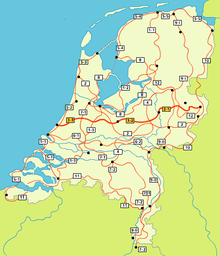
In The Netherlands, E11 is identical to the Marskramerpad (Peddlers Way), which links Scheveningen over 368 kilometers to the German township of Bad Bentheim. The last 13 km are on German territory, which leaves 355 km for the Dutch territory. Like most Dutch long distance trails, the Marskramerpad is managed by Wandelnet where Wandelnet: "Marskramerpad", ed. by Wandelnet, Amersfoort, 2009, ISBN 9789071068782, a guide in Dutch with very useful detailed maps can be bought. This booklet must be used in the reverse order, i.e. the map showing Scheveningen is the last map in the guide. This may explain why the cover text of the guide erroneously states that the Dutch part of E11 begins in the German town of Bad Bentheim.
Dutch hiking trails, including the Marskramerpad, are usually perfectly marked. However, trails are often changed, sometimes in a major way, and these changes are only described in Dutch. In December 2012, 55 changes were mentioned.
Not all changes are small. One of them (between Achterveld and Terschuur) amounts to an extra 8 km (5 mi), on top of the 360 km mentioned on the cover of the guide. This is why 4 maps in the booklet ("kaart 42", 42A, 43 and 44) have been modified completely. It is therefore advisable to order the guide and also check the markings of the Marskramerpad in the field for recent changes. Just on the main heading of the page you find four bottoms, of which the second from left produces a very detailed map of the most recent routing of the trail (use the zoom function). Elsewhere on the page, on the right side, you find a button called overnachtingsadressen. Clicking on that one gives you the addresses of lodgings along the trail.
It is possible to download a GPS trail of a recent version of the Marskramerpad. This is a private publication, and is not issued or checked by Wandelnet. It probably does not cover all changes in the routing either. For copyright reasons, neither this GPS track, nor a precise description of the routing can be given here, but the links in the following paragraphs offer the possibility to find more information about the towns along the trail.
The Netherlands section of E11 crosses from 🌍 Scheveningen through the town centre of 🌍 The Hague, then turns North-east to pass the former Royal mansion palace 🌍 Huis ten Bosch, continues into the estates of 🌍 Wassenaar, passes the mansion of King Willem-Alexander, leaves the wooded land to go between some pastures, enters the large village of 🌍 Voorschoten and proceeds to the second largest old town centre of the Netherlands, that of 🌍 Leiden. It goes on by 🌍 Leiderdorp and 🌍 Zoeterwoude-Rijndijk through authentic polders and wetlands past 🌍 Hoogmade and through picturesque 🌍 Woubrugge to 🌍 Rijnsaterwoude, the lowest point of the trail at 5 meters below sea level. On it goes by 🌍 Nieuwveen and 🌍 Zevenhoven to 🌍 Noorden and the town of 🌍 Breukelen which has a railway station. After 🌍 Maartensdijk, the scenery changes from wetlands into wooded dunes, through which the city of 🌍 Amersfoort is reached. Here you find intercity trains back to The Hague and Leiden, on to cities like Osnabrück, Hannover and Berlin, and, in case you want to leave the track for a day, Amsterdam. Amersfoort, however, has enough to offer for a day or two of rest.
After Amersfoort and 🌍 Leusden, the Marskramerpad/E11 enters a broad wet valley that consisted of marshes in the early Middle Ages, but was turned into little polders from 1000 years ago onward. The trail passes 🌍 Achterveld, 🌍 Terschuur and 🌍 Appel in the region called Gelderse Vallei. We are now in the municipality of Nijkerk, where the first settlers of New York City came from (Kiliaen van Rensselaer was a merchant from Amsterdam, but his family owned the still existing farmhouse "Rensselaer" between Nijkerk and Putten, and he was so fond of the local population that he took many of their sons to what is now Manhattan).
This area is also the gate to the woods and forests of the Veluwe, the largest area covered with trees in the Netherlands. Charming villages like 🌍 Stroe and 🌍 Kootwijk, the former antenna tower of Radio Kootwijk and the townships of 🌍 Hoenderloo and 🌍 Beekbergen are human landmarks in a sea of trees. But then the scenery becomes open and wet again, whilst 🌍 Klarenbeek (train station) and 🌍 Voorst are passed. The trail now follows the river IJssel for a while, passes under two large bridges with motorways, and then takes a ferry into the old city of 🌍 Deventer (under certain circumstances, such as flooding or ice on the river, the ferry will not go and you will have to cross the IJssel by the second bridge).
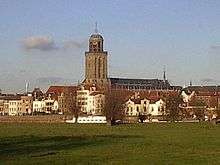
Deventer is the first township in the region of Salland and the province of Overijssel. Apart from the option to take the same intercity trains as in Amersfoort (see above), Deventer might be another town where you take a break, before venturing into the East of the Netherlands. Hikers who pass through Deventer before walking into Germany, may profit from a visit to the Wandelwinkel, a bookshop specialized in publications about hiking and related outdoor sports, where all German detailed maps are in stock. The shop is opposite the Bergkerk (Mountain Church; it is built on a little hill) in the most picturesque part of the town.
🌍 Diepenveen, 🌍 Lettele, 🌍 Okkenbroek and 🌍 Espelo are small villages surrounded by open agrarian land, but the Marskramerpad/E11 then climbs on a range of hills near the town of 🌍 Holten (train station). We now enter the region of Twente. Soon a further broad valley with open fields is reached and the trail meanders toward the interesting town of Delden. Instead of crossing the town, the path prefers the beauty of the estate of 🌍 Twickel, then curbs North to 🌍 Azelo and 🌍 Zenderen, touches the newest residential areas of 🌍 Borne and Hengelo, and passes 🌍 Deurningen on its way to charming 🌍 Oldenzaal.

The railway station of Oldenzaal is a crossroads of long-distance footpaths, such as the Naoberpad or Noaberpad on the Dutch and German border, and various Dutch trails. E11 continues Southeast, avoiding various settlements in the area, and finally crosses the 🌍 German border just before the village of Gildehaus, a part of Bad Bentheim. Note that the markings change as soon as you enter German soil: the white-and-red markings now make place for a white T on a black background. The last 13 kilometers of the Marskramerpad are German.
EUREGIO exploits the eastern part of the Marskramerpad and its continuation in Germany (together forming the stretch Deventer - Bad Bentheim - Osnabrück) under the name of Handelsweg. Its bilingual (Dutch, German) website offers downloads of topomaps and bookings of lodgings and luggage transport. This part of E11 is 229 km long. The name refers again to the peddlers of old, but translates as "Trade Way".
E11 in Germany (996 km)
_april_%C2%AE_DJE_2006_01.jpg)
The first 13 km in Germany, through 🌍 Gildehaus and 🌍 Bad Bentheim, are still part of the Dutch Marskramerpad and may be found on maps 1 and 2 of the Dutch guide. The markings date back to the time that this section was part of the Töddenweg: a white capital T on a black background. Bad Bentheim is also the first remarkable elevation, contrasting with the flat- and wetlands and occasional dunes of the Netherlands. Bad Bentheim has an interesting castle and museum and a charming little town centre with a spa in the woods nearbye.
In the rest of Germany, E11 follows some old regional trails, notably the Töddenweg, the Wittekindsweg (Widukind's Way) and part of the Wesergebirgsweg. A remnant of the Wanderweg Harz - Niederlande (Hiking Trail Harz - Netherlands) and a newly created routing in the former GDR form the rest of E11 in Germany. The path crosses former West-Germany on a chain of ridges running from West to East, then passes the Harz Mountains without going high, and finally gives an impression of the large-scale agrarian enterprises that were founded by the Brandenburg-Prussian nobility in the 17th century, and continued to exist in the form of People's Owned Companies during the GDR.
E11 is normally marked in various regional ways and only rarely is one reminded that one follows a European trail. It is therefore absolutely necessary to know the names of these trails and their symbols, as given below. Since they appear both as marks on trees and walls, and on detailed maps in which the trails are indicated, no further knowledge of the German language is needed to reach the Polish border. These maps are normally found in local bookshops only, but specialized may have maps from other areas in stock. Falk and ADAC publish road atlases on a scale of 1:200,000 on which E11 is remarkably well indicated. The atlasses are sold throughout Europe.
Töddenweg and Wittekindsweg (205 km)
E11 follows the border between the German federal states (Länder) of Lower Saxony and Northrhine-Westphalia over about 200 km, which means that one crosses their border at least every day. This is true for both the Töddenweg and the Wittekindsweg, which form the respective continuations of the Marskramerpad.

The Töddenweg (a regional name to be translated as Peddlers Way) used to begin in Oldenzaal in The Netherlands, but has its start now in Bad Bentheim, an old seat of German nobility with a medieval castle (partly museum) and a functioning spa. The Töddenweg passes 🌍 Schüttorf, 🌍 Rheine, 🌍 Dreierwalde, 🌍 Ostenwalde, 🌍 Hopsten, 🌍 Recke, 🌍 Mettingen and 🌍 Westerkappeln to end at the central station of 🌍 Osnabrück. A set of 3 maps can be downloaded or ordered from EUREGIO. A different map can be obtained from the website Spazieren.de (click on "T - Töddenweg (Download, GIF-Datei, archiviert/ZIP, 167 KB)) In its present form, from Bad Bentheim to Osnabrück, the Töddenweg measures 110 km. It is marked by stickers with a white capital T on a black square, or by a simple T painted on trees and walls. A GPS track may be downloaded here. It cruises slightly elevated above the surrounding agrarian land.
The continuation after Osnabrück's monumental railway station is called Widukind's Way (Wittekindsweg), named after an 8th-century war leader who resisted the conquest of Saxony by Charlemagne and later became the first Duke of Saxony under Charlemagne. The Wittekindsweg, 95 km long, follows the crest of the Wiehengebirge, passing 🌍 Rulle, Mühlenortnear Engter, 🌍 Vehrte, 🌍 Ostercappeln, 🌍 Wehrendorf, 🌍 Barkhausen, 🌍 Oberbauerschaft and 🌍 Bergkirchen to 🌍 Porta Westfalica. Just before the sensational descent to Porta Westfalica, the trail passes the giant monument to the honor of Wilhelm I, German Emperor from 1871 till his death in 1888. The building is placed in such a way that, even today, all who pass in a train or on the motorway, see it high on the slope that ends the Wiehengebirge.
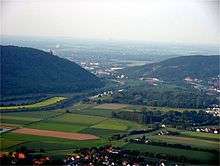
The Wittekindsweg is marked with a skewed white cross on a black background (or on trees and walls) from Osnabrück to Mühlenort, but afterward with the white and red stripes that remind of France and the BeNeLux countries. The stretch from Osnabrück to the Wittekindsberg, South of the city of Minden, is also found on Kompass map 750 (available in any good bookshop throughout Europe). Both the Töddenweg and the Wittekindsweg are under the management of the Wiehengebirgsverband Weser-Ems, a quango promoting tourism and other commercial interests of the region. They publish and sell detailed maps displaying the trail, which can be ordered from their website. For those who read German, their booklet with detailed description of the itinerary may be useful. A different map of the trail may be downloaded from Spazieren.de and click on "Wittekindsweg (Download, GIF-Datei, archiviert/ZIP, 209 KB)). Some detailed information about the trail is given in German by Wanderbares-Deutschland.de (click on Wittekindsweg in the list of trails in the left column of the page). A GPS track may be downloaded from Wanderkompass .
Eastern Lower Saxony and Harz Mountains (186 km)
After Porta Westfalica E11 remains in Lower Saxony for almost 200 km. It follows the 50 km of a regional hiking trail, the Wesergebirgsweg, cruising over the crest of the next ridge, the Weser Uplands to the medieval town of Hameln. E11 reaches a height of 440 meters on 🌍 Mount Hohe Egge, amidst of breath-taking rocks and ancient forests. It then crosses the open downs around 🌍 Hameln (junctions with E1) and 🌍 Coppenbrügge, near the rivers Hamel and Weser. The latter township offers the last possibility for shopping before E11 climbs the next ridge, the Ith and remains on its crest over its full length.
Passing 🌍 Eschershausen, medieval 🌍 Alfeld, the Helleberg ("Mount Hell") and 🌍 Bad Gandersheim, E11 reaches the Harz Mountains at the township of 🌍 Seesen. Although the mountain range offers summits of 1000 meters and more (the famous Brocken is over 1,100 m), E11 does not climb higher than 500 m and keeps mostly to the lower parts of the northern slopes. It crosses through a few townships well-known from early German history: 🌍 Goslar (junctions with E6) and 🌍 Bad Harzburg. The little river Ecker used to be the 🌍 German-German border and now separates the federal states of Lower Saxony and Saxony-Anhalt.
Detailed information about this part of the trail may be found in a publication in German, E11Mittel - Der E11 durch das Norddeutsche Mittelgebirge (2010); Fernwege.de; ISBN 9783937304809 (this guide describes E11 from Porta Westfalica to the city of Halle an der Saale in Saxony-Anhalt), on a German website FernwegeE11 and on several detailed topographical maps like Kompass 450. E11 is marked on trees and walls with a white skewed cross (X), occasionally on a black square and/or with the letter N to avoid confusion with other trails. The N refers to the old name of the trail, Netherlands - Harz Mountains. Note however that markings "X11", also with a white cross, refer to a different trail that runs parallel to E11.
Harz Mountains and Saxony-Anhalt (244 km)
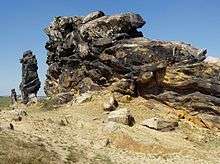
In the years after German reunification, the Harz Club put much effort into restoring the network of rambling trails in the Eastern part of the Harz Mountains. This resulted in a completely new extension of E11 through the federal state of Saxony-Anhalt. It passes 🌍 Ilsenburg, 🌍 Wernigerode, 🌍 Thale, 🌍 Gernrode and 🌍 Ballenstedt, breaks finally through the crest of the Harz Mountains (which are hills rather than mountains here) via 🌍 Pansfelde and 🌍 Wippra, and reaches 🌍 Lutherstadt Eisleben. The latter city is known as the town of birth of Martin Luther, the church reformer, and bears his name in its official name.
A further extension, long planned, but realized only in 2007, leads E11 through mining and large-scale agricultural area to the village of 🌍 Höhnstedt and the Natural Park of the Lower Saale (Naturpark Unteres Saaletal) E11 proceeds by 🌍 Schochwitz and 🌍 Dölau to the large city of Halle. The section until Halle is marked in the same manner as the previous parts, i.e. a white cross (X), possibly on a black square.
The remarkable city of 🌍 Halle survived the Second World War almost undamaged and retains a great number of buildings reflecting Jugendstil, Bauhaus and other architectural styles. After Halle, E11 climbs the lonely hill of 🌍 Petersberg and continues through flat, open land. The scenery reflects both the large scale of agrarian enterprises in the GDR as well as that of Brandenburg-Prussian nobility in the 18th and 19th centuries. E11 passes 🌍 Görzig and 🌍 Quellendorf to reach the city of 🌍 Dessau, the cradle of Bauhaus. The E11 then plunges into the thrilling nature of the Biosphere Reserve of the Middle Elbe. It passes 🌍 Vockerode, 🌍 Wörlitz and 🌍 Coswig and enters the forest around 🌍 Senst. Shortly after this village, E11 reaches the border with the federal state of Brandenburg. After Halle, E11 is marked according to the traditional system in former communist Europe: three horizontal stripes, white, blue and white, which may also be interpreted as a blue stripe on a white square.
In Saxony-Anhalt, E11 is found on the maps published by Kompass, notably 450 or 452 and 453 (Harz Mountains until Eisleben), 457 (Eisleben to Halle), 458 (Halle to Dessau) and 456 or 747 (after Dessau). Alternatively, topographical maps may be acquired locally. Useful information in the German language can be found on the website of Fernwege.de by clicking on "PDF Touren download", "Wander-Shop" and "Fernwanderwege in Deutschland" (the section between Halle and Coswig is still missing).
Brandenburg and Berlin (348 km)
E11 enters Brandenburg near 🌍 Groß-Marzehns and crosses treeless large-scale agrarian land until the picturesque town of 🌍 Belzig. The trail continues through vast hunting forests, which were the property of the Brandenburg-Prussian nobility in the 19th century and served as a green zone around Berlin and Potsdam in the 20th century. About 20 km before Potsdam, E11 reaches the first of a 🌍 score of lakes zoomed by many former GDR holiday resorts, some of which still manage to linger on.
Crossing 🌍 Potsdam near the Central Railway Station takes little time as E11 avoids the interesting historical town center and the luxurious palaces of the former dukes of Brandenburg, who became kings of Prussia and emperors of Germany. E11 sneaks through one of the hottest spots on the former border of Berlin, 🌍 Klein Glienicke. This little settlement enclosed by water and divided by a dented border, was packed full of spies by both superpowers during the Cold War. The Glienicke Bridge witnessed the opening and subsequent fall of the Iron Curtain in 1989.
The routing through former West-Berlin surprises with a vast area of forest before the 🌍 Olympic Stadium in Charlottenburg is reached. This part of Berlin is rich in historical castles, including the winter residence of the Prussian kings, who also founded a few museums here. Most of the famous museums of Berlin are, however, found in Mitte (the historical center of Berlin and also the center of East-Berlin in GDR times. E11 does not pass here, but follows an old trail of West-Berlin along the River Spree and the 🌍 Landwehr Canal, thus missing the most interesting parts of former East-Berlin and present-day Berlin.
The borough of 🌍 Köpenick is where E11 enters former East-Berlin territory. E11 lingers leisurely between the River Spree and a few recreational parks and then crosses the river by ferry into a vast area of town houses and bungalows to 🌍 Friedrichshagen. Here, E11 leaves the urbanization behind to venture to the North into one of the most beautiful parts of the trail, the valley of the little 🌍 river Erpe or Neuenhagener Mühlenfließ. Turning East, the trail now passes through 🌍 Neuenhagen and the Märkische Schweiz Nature Park to 🌍 Gusow near the town of 🌍 Seelow. From here, the rambler may choose a more western trail over the hills of Lebus to Jacobsdorf or, more to the East, the trail that, after the village of 🌍 Reitwein, follows the River Oder to the South. Both variants meet each other in 🌍 Frankfurt (Oder), where the German part of E11 ends on the bridge over the Oder to Poland.
_01.jpg)
In Brandenburg and Berlin, E11 is marked in various ways. The white-blue-white stripes coming from Coswig in Saxony-Anhalt continue till Luisium. White-red-white markings take over toward the little village of Wörlitz (Brandenburg; not the bigger township of the same name in Saxony-Anhalt) and white-blue-white stripes bring the rambler to Potsdam. In front of Potsdam's monumental central railway station (Potsdam Hauptbahnhof) E11 meets E10, running North-South and also marked white-blue-white. A yellow X takes the rambler through former West-Berlin to the begin of Köpenick, from where white-yellow-white stripes lead through this borough and that of Friedrichshagen. White-red-white stripes follow and bring the hiker to Neuhardenberg. while white-blue-white stripes accompany the journey to Frankfurt (Oder).
This part of E11 is described in the German language book Wanderungen durch Brandenburg, Unterwegs auf den Europäischen Fernwanderwegen E10 und E11 (Description of E10 and E11 in the federal state of Brandenburg), Trescher Verlag (2003). ISBN 9783897940338. A list of 150 addresses which offer lodgings for the night en route, also in German, is found in specialized bookshops Übernachtungsverzeichnis zum europäischen Fernwanderweg E11 in Brandenburg ISBN 9783937304410. Some useful information is found at Fernwege.de but as such not enough to follow the trail. It is strongly advised to carry a city plan of Berlin when walking from Potsdam to Neuenhagen. Locally bought topographical maps will do for the rest of the trail in Brandenburg.
E11 in Poland (1,209 km)

In Poland, E11 continues to the east, then to the northeast, to pass the cities of Międzychód, Poznań, Gniezno, Toruń, Brodnica, Iława, Olsztyn and Gołdap to the township of Ogrodniki in Sejny County on the Lithuanian border. As 30% of Poland is covered with forest, it will not be surprising to find that most of E11 crosses through vast areas with trees (mostly planted and exploited in a commercial way), and various forms of wild nature, such as lakes and dunes. Near Poznań, however, the rambler walks for days through agrarian and semi-industrial land, made pleasant by some ancient towns and buildings.
As Poland is rather scarcely populated, the more so when going East, ramblers without tents must be prepared for daily distances between 25 and 35 km. Where the routing is shown in detail below, the distance from the beginning of the section is added to the name of a township to indicate that the town offers some form of accommodation. For example, "Wronki (88 km)" in the section "Międzyrzecz - Poznań-Kiekrz" means that there is a hostel, hotel or other accommodation in the town of Wronki, 88 km after Międzyrzecz.
No Polish regional trail is, as a whole, part of E11. The trail rather jumps from one existing trail to another, generally after following such a trail over a short distance only. Moreover, E11 is not indicated in the field as such, with a few exceptions which may add up to one sign every 100 km. The regional trails are marked, however, although not always well enough to enable the rambler to find E11 without a map. The marking system is always the common Central European, i.e. white-colored-white, but due to the many changes from one trail to another, the color varies a lot. This is why, in the details of the routing of each section below, the color of the markings is indicated. For example, "Drzecin (yellow)" means that in Drzecin, E11 begins to follow a trail marked with yellow stripes on a white square.
Some topographical maps show sections of E11, but others may only show the trails that form the basis for it. It is therefore necessary to fall back on documents describing which sections of which trails form E11 together. Unfortunately, these are hardly accessible or incomplete:
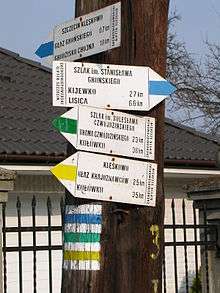
1. A German book summarizing the routing of all eleven European long distance paths. Hans Jürgen Gorges: Auf Tour in Europa, ed. Kompass & European Ramblers Association (1999/2000 and 2002). This is an (even second-hand) completely sold-out summary of the E-trails, getting obsolete due to changes in the routings.
2. A series of Polish topographical maps (with legend in English) showing hiking trails, but not always indicating which of these belong to E11. "Poltopo" Oddział Topograficny Sztabu Gen. WP: Mapa Topograficzna Polski §, where § stands for the number of the map, i.e. "N-33-125/126" for the first map after Frankfurt (Oder). These and some more detailed maps may be ordered from abroad at the specialized map shop Grupa.18 in Poznań.
3. Later changes in the Polish routing can be found (in Polish) in the offices of PTTK, the Polish tourist organization. and (in English) at the secretariat of the European Ramblers Association in Prague.
4. You can't find your way with the help of German maps, however detailed they are. These maps tend to show the German names of townships as they were in use until 1945, but these names are nowhere to be found in the area. The German inhabitants of old were forcibly resettled in Germany and are no longer there, whereas the present Polish inhabitants are mostly the children of those who were equally forcefully resettled from areas that once belonged to Poland, but are now parts of Belarus and Ukraine, some thousand kilometers to the east. Thus none of the locals is able to trace an old German name to a modern Polish settlement.
Oder bridge - Międzyrzecz (141 km)
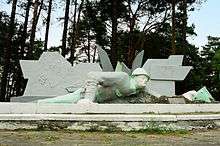
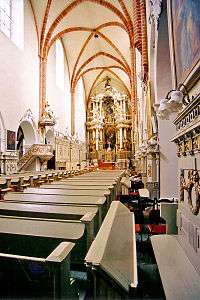
Once the bridge across the River Oder (and the now open border between Germany and Poland) has been passed, E11 (here unmarked) goes straight through the town center of 🌍 Słubice, until 1945 a suburban part of Frankfurt (Oder) under the name of Dammvorstadt, but a separate township in a different country since then. Going straight all the time for two kilometers, the rambler reaches a small parcel of forest. Here E11 curbs left toward the little village of Drzecin, where the first white-yellow-white markings are found. These lead in a few days to Lubniewice, where the markings change to white-blue-white. Up to here, map N-33-125/126 suffices, although it does not mention E11. Map N-33-127/128 has a new edition that shows the precise course of E11 from Trzebów. The detailed routing is: Oder bridge between Frankfurt (Oder) and Słubice - town center of Słubice (no marking) - 🌍 Drzecin (yellow) - 🌍 Stare Biskupice - 🌍 Sułów - 🌍 Drzeńsko - 🌍 Lubiechnia Wielka - 🌍 Lubiechnia Mała - 🌍 Ośno Lubuskie (34 km) - 🌍 Trzebów - 🌍 Jarnatów - 🌍 Lubniewice (67 km).
The blue trail passes Kursko and leads to Kęszyca Leśna, a former army base of the Soviet Red Army that now tries to build up a second life as an industrial and tourist settlement. The former staff quarters now function as a hotel, where the hiker may rest as a Soviet general. A little further lies Kęszyca, where a German system of underground corridors and strongholds can be visited. This dates back to the 1920s, when democratic Germany (the Weimar Republic) felt the need to defend itself against a possible attack from the east. In the 1930s already, this defense system started to deteriorate as dictator Adolf Hitler was more interested in attacking himself to the east and saw no need for a defense system that, from his point of view, lay somewhere inland in his dreamed Greater Germany. The spot offers now the unique possibility of following E11 underground.
(blue) - 🌍 Osiecko - 🌍 Bledzew (78 km) - 🌍 Chycina - 🌍 Gorzyca - 🌍 Kursko (93 km) - 🌍 Kęszyca Leśna (100 km) - 🌍 Kęszyca - 🌍 Rez. Nietoperek - between Kaława and Wysoka - 🌍 Gościkowo, with Paradyż abbey (112 km) (green) - 🌍 Szumiąca - 🌍 Bobowicko (141 km). The blue trail carries E11 until the township of Gościkowo, where the Paradyż Abbey sometimes hosts tired ramblers overnight, provided they accept the sober rules of monk life. After Gościkowo, white-green-white marks lead through some 30 km of forest to Bobowicko.
Between Kursko and Bobowicko, E11 follows a large bow around the city of Międzyrzecz. The city has bus and train connections with various townships on E11 and may be used as a pleasant station for two or three days of walking without much luggage. Bodowice is at walking distance (2 km) from the train and bus stations of Międzyrzecz. Due to its train connections to Poznań and Germany, Międzyrzecz is also a good place to end or start a tour of one or more weeks along E11. The city has an interesting regional museum and a lively score of restaurants and bars.
Międzyrzecz - Poznań-Kiekrz (133 km)

From Bobowicko, the green trail continues till after Stołuń, where E11 begins to follow white-blue-white to Villa Toscana, a lonely hotel between the villages of Nowe Gorzycko and Stare Gorzycko. The blue trail and E11 continue to the twin cities of Międzychód and Bielsko, which offer many opportunities for shopping (fashion, antiquities, arts) and staying overnight. E11 now enters the area that, for a long time, was No Man's Land and War Front Zone between Prussia (later the German Empire) and Poland. Many monuments remind of this tragedy, but the explanatory texts are in Polish only. In Bukowar the markings change to white-red-white and in Obrzycko to white-green-white. Słopanowo marks the end of the forests; E11 now enters the agrarian open space of the province of Greater Poland around the city of Poznań. There are no marks after Szamotuły. The village of Kiekrz is where E11 reaches Poznań.
Maps N-33-127/128, N-33-129/130 and N-33-117/118 do not mention E11, but show the underlined trails in the right color until Szamotuły. The precise routing of E11 is: Bobowicko (green) - 🌍 Żółwin - 🌍 Kuligowo - 🌍 Stołuń - 1 km before Rybakówko (blue) - Villa Toscania (27 km) - 🌍 Stare Gorzycko - 🌍 Słodewy Młyn - 🌍 Międzychód (33 km) - 🌍 Bielsko (36 km) - 🌍 Ławicá - 🌍 Góra - 🌍 Sieraków (53 km) - 🌍 Piaski - 🌍 Bucharzewo - 🌍 Bukowar (red) - 🌍 Pustelnia - 🌍 Chojno - 🌍 Chojno Błota - 🌍 Mokrz - 🌍 Wronki (88 km) - 🌍 Obrzycko (99 km) (green) - 🌍 Słopanowo - 🌍 Kobylniki - 🌍 Twardowo - 🌍 Szczuczyn - 🌍 Szamotuły (113 km) (no marking) - 🌍 Kępa - 🌍 Baborówko - 🌍 Pamiątkowo - 🌍 Krzyszkowo - 🌍 Rokietnica - 🌍 Starzyny - 🌍 Poznań-Kiekrz (133 km).
E11 through Poznań (33 km)
From behind the railway station of Kiekrz, a white-green-white marked trail leads through a vast city park to 🌍 Golęcin, from where a few black or blue marks guide the rambler to the tramway stop of 🌍 Sołacz and 🌍 Nad Wierzbakiem. After this point, E11 is not defined, but the obvious choice of a rambler interested in one of the oldest, biggest and most beautiful town centers along E11 is to turn right (south) toward 🌍 Rynek Jezycki. Here begins The Royal-Imperial Route in Poznań which, in a more or less straight West-East line, passes all touristic highlights of Poznań, among others the 🌍 central square of Poznań, Rynek and Rondo Środka. This tourist trail ends at the medieval little Church of St. John of Jerusalem Outside the Walls near Lake Malta. The quiet northern shore of this 🌍 Jezioro Maltańskie offers interesting views of the many sports accommodations on and around the lake and guides the E11 rambler to Krańcowa/🌍 Nowe Zoo and the start of the well-marked but curving Cistercian bicycle track (black monks on a white field or simple black stripes). Its many curves lead around the zoo, through 🌍 Poznań-Antoninek to the last residential area of Poznań, 🌍 Zieliniec. Lodgings and buses back to town are found just across the border of the city in 🌍 Gruszczyn (35 km). For this part of the track, a detailed plan of the city is recommendable. Free street maps of the center of Poznań and leaflets with information about the Royal-Imperial Route are found in many hotel lobbies and in the tourist information centers.
Poznań-Zieliniec - Gniezno (55 km)
Crossing the main road in Gruszczyn, E11 goes straight, now following a different bicycle trail, which is marked with a black stripe on a white square (the Cistercian route, by the way, turns left here and ends after two kilometers at the railway station of Kobylnica, although Map N-33-131/132 suggests that it continues straight to Pobiedziska.) E11 passes over a tar road through a nondescript area of small businesses and workshops related to agriculture until, just before the little village of Pomo (not shown on map N-33-131/132), it turns left and immediately right again into a sandy forest road. This spot is marked by a stone pillar indicating various hiking and biking trails.
Having ventured into the forest for 2 or 3 kilometers, you reach a crossing of sandy roads where a hiking trail marked white-green-white comes from the left. E11 and the black bicycle trail turn right to follow the green trail over several kilometers and across a paved road, until finally all black or green markings disappear. Here you should follow white-blue-white markings which, after another kilometer, turn out to mark the same trail as the green hiking and black biking routes. The scale of the topo-map, 1:100,000, does not allow to display all these details, so that a good sense of direction (assisted by a compass and sunny weather) is required.
The combined blue, green and black routes reach a second tar road, which they follow to the left (north) over a few hundred meters. The green and black signs are nowhere to be seen, but the blue trail turns right into a sandy forest path and the map indicates that this is E11. After about a kilometer, the markings leave the path and invite the rambler to find his steps among the trees. The blue stripes are now corroborated by green stripes (both on a white square) and are convincingly frequent, so that it is quite frustrating to learn that both routes, after splitting up, die somewhere in the forest and the dunes. Romantic ramblers may be reminded of Hansel and Gretel and start searching for the edible house of the bad witch, but in earnest, there seems to be no other solution than to go back to the tar road and follow it to the right (north) to the township of Pobiedziska, where E11 is found back.

The stretch between Pobiedziska and Gniezno is poorly documented. The only known source is a big map of the area, placed on the central square near the main church of Trzemeszno, a township further down E11. In Pobiedziska, a clearly marked trail guides hikers and bikers to the local railway station, but E11 and two bicycle trails follow, unmarked, a different street. This is the ulica Gnieźnieńska at the left of the church on the central square of Pobiedziska. After a kilometer the road and the routes cross the railway. In Glówna, bicycle trail #12 turns left, but E11 proceeds along an unnumbered bicycle trail, also marked black, to the village of Węglewo. E11 and the unnumbered bicycle route make two right turns in Węglewo and a left turn just outside, to continue on a stony dirt road.
Five hundred meters before the dangerously busy main road #5 is reached (don't put your hopes on signs indicating that meals or drinks might be served), in the long-stretched village of Moraczewo, E11 and the bicycle route curve left toward Lednogóra where white-red-white markings join the trail. This is from now on the colour of E11 over more than 100 km. From the church in the little village with scattered houses, it is about 2 km to the main road #5, which is followed to the left over a newly paved footpath along a swampy lake. After another kilometer on this path, a crossing in the main road is reached. A huge red neon sign draws attention to a motel ahead on the main road; a humble signpost points to the youth hostel of Dziekanowice to the left; but E11 turns right to cross the main road and follow a tar road to the South. At the crossing a road sign says that it is now 22.2 km to Gniezno.
The tar road and E11 reach the railway track and follow it to the left, but where the tar road crosses the rails, E11 goes straight on a stony dirt road parallel to the railway. There are no markings here; the first white-red-white stripes are found just before the station of Fałkowo, where E11 turns right across the tracks into the township. Fałkowo is crossed at full length until you reach a motorway (in September 2011, the road was still under construction and a new routing of E11 had not been established. Please add new information here.) After Leśniewo scarce white-red-white signs can be found again, leading the aware and persistent rambler to Gniezno.
Gniezno was the first capital of Poland, way back in the Middle Ages, but it is now dreaming away as a provincial town. Old and beautiful houses and other buildings around the central square testify of an interesting past, whilst decaying factories refer to the recent communist past. The university offers the most lively corner of the town. The white-red-white marks of E11 lead along the most interesting churches, museums and other sites, and finally to the railway station.
The routing of E11 in this section can be summarized as: Poznań-Zieliniec (bicycle track marked with a black Cistercian on a white square) - Gruszczyn (1 km) (bicycle track marked white-black-white) - 🌍 Uzarzewo - 🌍 Biskupice - Rez. Jezinowo Dębiniec (green) - Rez. Drazynek (blue) - forest near Kapalice (no markings) - 🌍 Pobiedziska (22 km) (bicycle track marked white-black-white) - 🌍 Glówna - 🌍 Węglewo - 🌍 Moraczewo - 🌍 Lednogóra (red) - 🌍 crossing near Dziekanowice (33 km) - 🌍 Fałkowo - 🌍 Leśniewo - 🌍 Pierzyska - 🌍 Wożniki - 🌍 Gniezno (55 km).
Gniezno - Toruń (136 km)
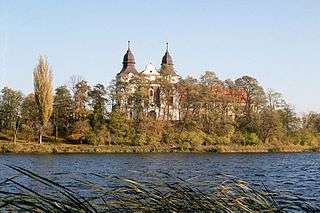
A few signs in front of the railway station of Gniezno indicate distances along the red-marked trail that is E11. The 40 km to Mogilno are correct, but the distance to Kruszwica is severely exaggerated. The trail follows the road parallel to the tracks to the Northeast and turns then right into a tunnel under the railway. After another right turn, it passes through a modern industrial area, older residential quarters and a surprisingly wild patch of forest. The red markings lead through open agrarian land to the long-stretched industrial village of Trzemeszno. The trail passes in front of the railway station, crosses the tracks a little further, and reaches Mogilno via the village of Wydartowo.
The maps needed for this section are N-33-131/132, N-34-121/122, N-34-109/110 and N-34-97/98. E11 is not mentioned on these maps, but the red marked trails are partially covered, namely from Gniezno to Trzemeszno. From Trzemeszno to Strzelno, the E11 is shown on a locally published topographical map Mogilno na Szlaku Piastowskim, ed. Artem, Witkowo, 1:50 000, ISBN 8391396967. The precise course of E11 in this section is: Gniezno (red) -Pławnik - 🌍 Kędzierzyn - 🌍 Nowa Wieś Niechanowska - 🌍 Krzyżówka - 🌍 Miaty - 🌍 Trzemeszno (23 km) - 🌍 Niewolno - 🌍 Folusz - 🌍 Wydartowo - 🌍 Duszno - 🌍 Izdby - 🌍 Gozdawa - 🌍 Wyrobki - 🌍 Mogilno (41 km)
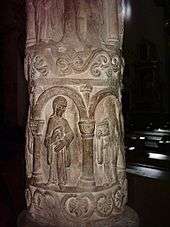
The white-red-white stripes die out in Mogilno. E11, now invisible, turns right in the little park around the lake, not far from the railway station, and immediately right again, to follow the waterside toward the medieval Benedictine monastery. E11 turns left (east) along a busy narrow road to Bystrzyca, where it turns into a backstreet to Olsza. The lengthy village street of Podgaj and Kawka delivers the rambler at the lonely motel of Goryszewo Kwieciszewo. The exact routing in this part of the trail is: Mogilno - 🌍 Bystrzyca - 🌍 Olsza - 🌍 Goruszewo - 🌍 Kwieciszewo (51 km).
Here, the first white-red-white stripes since Mogilno are found. These fail to mark where E11 leaves the main road and hops to a dirt road running parallel to the main road, a few hundred meters to the South. The dirt road is scarcely marked until the entrance of a forest; then the marking activities have stopped completely. Ramblers who go straight through the wood, find red markings at the other side. E11 passes through Jeziorki and follows a sandy dirt road to Strzelno (the hotel indicated on maps in this town has shut its doors many years ago). After Strzelno, a Polish Way of St. James follows more or less the same route as the E11, so that the yellow and blue shells yield an alternative marking. E11 and the Way of St. James pass the attractive baroque church of Strzelno and the nearby village of Starczewo and, via Ksiaż, reach Polanowice. In this soviet-industrial village two rusty signs with white-red-white stripes are found, which still clearly indicate E11 (200 km after the previous E11 sign!) A rustic tree lane brings the rambler to Kruszwica, a provincial town with some interesting churches. The details of E11's course in this paragraph are: Kwieciszewo - 🌍 Jeziorki - 🌍 Strzelno (both red and Way of St. James) - 🌍 Starczewo - 🌍 Ksiaż - 🌍 Polanowice - 🌍 Lagiewniki - 🌍 Kruszwica (72 km).
Kruszwica shows no clue where E11 and the Way of St. James continue. Gorges invites to look for a trail marked blue, but the only blue trail to be found makes a short circuit through a suburb of Kruszwica. A better bet is to follow the busy main road to the North, which is marked with the shells of St.James. After 7 km, near Łojewo, one may take a quiet asphalt road to the skewed left, soon unpaved and marked blue. The blue signs lead finally through long-stretched suburbs to the city center of Inowrocław. The part of E11 in this paragraph runs: Kruszwica (Way of St. James shells) - 🌍 Szarlej - 🌍 Łojewo (blue) - 🌍 Szymborze - 🌍 Inowrocław (87 km).
Near the railway station of Inowrocław, a torn map of the city is found, which indicates where the red-marked E11 leaves the town. At a few points in town one still finds the white-red-white stripes. No markings whatsoever have survived in the villages up to Kolonie Szadłowice, but one may follow a green-marked bicycle trail. Somewhere among its scattered farmhouses, E11 turns right into a skewed dirt road that enters a forest, passes a military site (not on the map), curves to the North and turns right after about one kilometer into a sandy road that curves to the Northeast. All the time passing through the forests of Błoto Ostrowskie, E11 follows this sandy road without curves over almost three kilometers, until it reaches a T-junction and a wooded bank. The main road turns sharp right; a minor path goes left; E11 however breaks through the wooded bank into a large piece of grassland. If one enters the field and keeps to the left, one finds the next white-red-white stripes on a lonely tree in the grassland. It is an arrow this time, pointing back to Inowrocław, but if one follows the signs in the opposite direction, one comes to the village of Wierzbiczany. After a right turn outside this village, both the red markings and the blue shells of St.James lead through agrarian land to Gniewkowo. From the railway station of Inowrocław, E11 runs (red) - 🌍 Jacewo - 🌍 Balin - 🌍 Slońsko - 🌍 Pieklo - Kolonie Szadłowice - 🌍 Błoto Ostrowskie - 🌍 Wierzbiczany - 🌍 Gniewkowo (106 km).
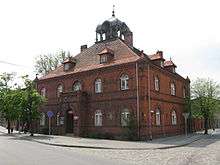
At the railway crossing at the entrance of Gniewkowo, the red signs turn left to the railway station, but E11, now marked blue, and the Way of St. James go straight into the center of the township. They follow a right curve and leave the town on the asphalt road towards Cierpice to the North. In spite of Gorges E11 no longer passes through Suchatówka. The trails now enter a large forest, leave the tar road after some kilometers and make a wide curve of 16 km to the village of Cierpice, the first of a chain of suburbs of Toruń. The blue signs bring the E11 rambler without problems from Cierpice to and through Mała Nieszawka, but after this village, shortly before the railway station, the trail turns left without notice, into a road plastered with concrete. The trail climbs over a dyke and reaches the river Vistula (Wisla). Here it turns right into an unpaved track, to pass a few ruins and reaches the bridge to Toruń. The blue trail ends at the PTTK office in the town centre, after running Gniewkowo (blue) - 🌍 Cierpice (122 km) - 🌍 Mała Nieszawka (130 km) - 🌍 Toruń (136 km).
Toruń - Brodnica (87 km)
From the PTTK office in Toruń, E11 is identical to a trail marked white-yellow-white, which leads all the way to Samborowo, 200 km to the northeast. The maps N-34-97/98, N-34-109/110 and N-34-99/100 do not mention E11, but the yellow trail that is used by E11, is shown in violet between Toruń and Golub-Dobrzyń, as well as from Pólka Duża to Brodnica.
E11 and St. James Way avoid the historical town center of Toruń and pass between city walls and river Vistula (Wisla), but it is far more interesting to cross the city center from the PTTK office by Różana, Szeroka and Wielkie Garbary to the railway station of Toruń-Miasto.
Out of town, the trails follow a main road till Fort Sobieskiego, then turns right into the forest near the river Vistula, but is forced to enter a (badly marked) suburban residential area after only two km. It is only after Kaszczorek and Złotoria that the trails pass through forest for a couple of hours. After crossing the busy motorway A10 near Brzozówka Kuyavian, you may turn right to reach a motel at 1 km. The details of this stretch are: Toruń (yellow) - 🌍 Kaszczobek - 🌍 Złotoria - 🌍 Brzozówka (20 km).
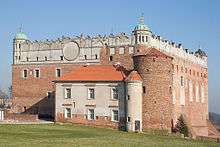
Back at the crossing of Motorway A10 near Brzozówka, E11 turns left into an overgrown footpath and later reaches Mierzynek over a sandy road. Map N34-97/98 shows an older routing by Szembekowo. From 🌍 Lelitowo to 🌍 Ciechocin (32 km) and again to Golub-Dobrzyń, E11 continues through a variety of natural and commercial forests along the river Drwęca, passing 🌍 Dulnik and Antoniewo to 🌍 Golub-Dobrzyń (44 km).
Map N-34-99/100 displays an erroneous course for the yellow trail until Pólka Duża (this village is not mentioned in the map). Actually, E11 leaves the twin cities without markings near the Post Office and the cemetery on National Road # 534 to Rypin. The trail turns left, to follow the river Drwęca to the North-East, and the first yellow signs are found in the forest. The trail then alternates between river side woods and agrarian settlements. Some of these remind of the composer Chopin who lived in this area and now has a museum in Szafarnia.
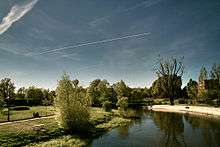
In Radziki Duże E11 turns left over a paved road with heavy lorries carrying loads from a sand quarry. It takes about an hour to reach a bridge over the Drwęca and escape from the road into the forest on the other side of the river. This sandy forest road continues till Mszano, but in a new suburb under Szabda it turns into a paved road and subsequently a boring main road leading to Brodnica, entering the city near the only hotel. The details of the course are: 🌍 Białkowo - 🌍 Szafarnia (53 km) - 🌍 Płonne - 🌍 Rodzone - 🌍 Tomkowo - 🌍 Kierz Radzikowski - 🌍 Radziki Duże - 🌍 Kupno - 🌍 Pólka Duża - 🌍 Słoszewy - 🌍 Mszano - 🌍 Szabda - 🌍 Brodnica (87 km).
Brodnica - Olsztyn (237 km)
Maps N-34-99/100, N-34-87/88, N-34-89/90 and N-34-77/78 do not mention E11, but show the underlying regional trails in the correct color (yellow being replaced by violet), with one exception: no trail is shown between Marianowo and Ostrowite.

E11 and St. James Way leave Brodnica well-marked, but avoiding the nice but neglected old city centre. The trails follow Motorway A15 and an abandoned railway track into forest, and meet the A15 again near the bridges of Tama Brodzka. Right after the bridge, the trails turn left into a small paved forest lane leading to Bachotek, where they split. The St. James Way offers a 24 km shorter option by Nowe Miasto Lubawskie to Radomno. E11 makes a few curves through the nature conservation area of Zbiczno lake and meets a trail marked green. Here the yellow signs are missing, but the green signs must be followed to the North until a paved road. The asphalt is followed to the East over about one kilometer between two lakes. Here the green trail and the yellow-marked E11 split up. (The green trail offers another short alternative for E11. It enters some of the most gratifying and adventurous pieces of wild nature in the area, reducing the distance by about 20 km.) E11 makes an almost full circle through rather dull woods and open land, passing twice near the tourist resort of Ciche and turning West to Górale, then North to the railway station of Ostrowite, and finally East.
The correct routing along the trails in various colors is: Brodnica (yellow) - Tama Brodzka (7 km) - 🌍 Bachotek (13 km) - Zbiczno lake - 🌍 Leśniczówka Rytebłota (23 km) (lodgings may be found near Ciche at 2 km) - 🌍 Górale - 🌍 Wonka (39 km) - 🌍 Ostrowite - 🌍 railway station of Ostrowite - 🌍 Łakorek (50 km, lodgings may be found again in Ciche, by following the paved road to the South over 4 km).
From Ciche one need not turn back to Łakorek by the paved road; the green-marked trail mentioned before offers a sensational alternative (pick it up in the forest East of Ciche). From the crossing of the green trail with E11, the now yellow-marked E11 continues to the East; through wood it goes to Sluzka, then through open agrarian land to the remarkable church ofGryżliny}}. A new routing carries E11 to Radomno, where it unites with the St. James Way. Both turn North at the eastern side of a string of lakes to reach Iława amidst rail tracks. In detail, E11 runs from the crossing with the green trail (yellow) - 🌍 Sluzka - 🌍 Skarlin - 🌍 Lekarty - 🌍 Gryźliny - 🌍 Radomno (73 km) - 🌍 Katarzynki - 🌍 Iława (85 km)
The trails pass the modern center of the city, which was heavily destroyed in the Second World War (first by the German Army, then by the Russian Red Army), and continue North through long-stretched Szalkowo, a water sports resort. E11 continues on a paved road between fields to Wiewiórka, then enters wooded land to reach the railway station of Samborowo. In detail: Iława - 🌍 Szałkowo (91 km) - Wiewiórka - 🌍 Tynwałd (99 km) - 🌍 Frednowy - 🌍 Wiewiórka - 🌍 Samborowo (112 km).
At the railway station of Samborowo, a blue-marked section of E11 to Waplewo, passing the historical site of Battle of Grunwald begins. Right after the start it is difficult to find: in the village of Samborowo it turns unexpectedly right, along the main road, to take the second bridge to the left and follow an old railway track over 9 km. Where it reaches a lone roadside cafe, E11 follows a paved road to the left, then another one toward long-stretched Pietrzwałd and the forests around Wysoka Wieś. There is a cheap hostel in Pietrzwałd with no visible signpost, while various luxury places can easily be found in Wysoka Wieś. Samborowo (112 km) (blue) - 🌍 Turznica - 🌍 Gruda - 🌍 Naprom - 🌍 Pietrzwałd (129 km) - 🌍 Wysoka Wieś (132 km).
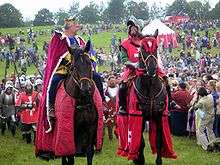
A variety of wild and tamed nature (forest, wood, neglected fields, wasteland and farmland) decorates the trail past Grunwald to Waplewo. This Grunwald is the most important national site of the Polish people: it commemorates a medieval battle in which the Polish defeated an army of the German Knights. The trail is sometimes difficult to follow, as markings are scarce and the path may be overgrown, so good sense for direction and a compass are required. The villages along this part of E11 are Wysoka Wieś - 🌍 Dylewo - 🌍 Marcinkowo - 🌍 Samin - 🌍 Grunwald (156 km) - 🌍 Ulnowo - 🌍 Lubianek - 🌍 Sitno - 🌍 Waplewo.
After Waplewo, the scenery changes radically: open land makes place for wood, then forest. Two natural parks protect a great number of rare species (plants, mammals, birds and insects) and justify the large detour that E11 makes to the South before turning North. After Maróz there is only one place where one can find a bed: the "agroturystyka" in Brzeżno Łyńskie of a Polish lady who speaks English, French, German and Russian. To begin the 25 km long stretch through the Las Warminski natural reserve from here is a feast, which is regrettably disturbed by the extended apartment buildings and city motorways of Olsztyn. This section of E11 passes Waplewo - 🌍 railway station of Waplewo (black) - 🌍 Maróz junction (183 km; lodgings in Maróz at 1 km) - 🌍 Żelazno (yellow) - 🌍 Łyński Młyn (green) - 🌍 Orłowo - 🌍 Likusy - 🌍 Brzeżno Łyńskie (203 km) - 🌍 Kurki - 🌍 Las Warminski - 🌍 Ruś - 🌍 Bartążek - 🌍 Jaroty (232 km) - 🌍 Olsztyn (237 km).
Olsztyn - Gołdap (243 km)
Maps N-34-77/78, N-34-65/66, N-34-67/68 and N-34-69/70 do not mention E11, but display the underlying regional trails in the colors with which they are marked (yellow shown as violet). Exception: the stretch from Lidzbark Warmiński to Kętrzyn is not shown in the maps. Part of this, however, is shown in blue on a detailed map of eastern Masuria that can be acquired locally: PPWK/Copernicus: Grosse Masurische Seen 1:100 000, ISBN 9788376970035.
Olsztyn has a most interesting historical city centre that to a large extent has been restored. The museums and shops invite to a day of rest, before one sets out to follow E11 on the Copernicus Path. Its red markings lead from the PTTK office to the North of the city and under a huge railway viaduct. The trail follows the western bank of the river Lyna, but the eastern bank offers a number of attractions, including a canopy walk and a rope bridge over the river. After the Smętka bridge the city noises are no longer heard and the trail becomes a quiet footpath through river bank wood. The village of Dywity used to be on the trail, but is now passed at a distance. Wood dominates until the rural settlement of Swobodna; fields and pastures follow, while E11 and the St. James Way pass the pilgrim's hostel of Głotowo and the provincial town of Dobre Miasto. The details of the routing are: Olsztyn (red) - Os Wojska - 🌍 Braswald - 🌍 Barkweda - Strusiolandia (18 km) - 🌍 Cerkiewnik - 🌍 L. Chmury - 🌍 Swobodna - 🌍 Głotowo (32 km) - 🌍 Dobre Miasto (37 km).
From Dobre Miasto a narrow paved road with busy traffic leads E11 Northwest through Kunik. After this village the red markings of the Copernicus Path and E11 turn right into a one-lane paved road that gives access to the bishop's palace of Smolajny. There is no doubt that the trail swarves over the clerical grounds, then crosses another paved road and enters the open fields at the other side of the road. But when, after about 1 km, it enters a marsh, all traces of markings are vanished. No path seems to continue from here, except for an overgrown cart track that leads back to the church grounds. The only way out of this maze is to go back to the paved road and take it to the left (Northeast) through the village of Smolajny up to its ending at National Motorway #51. This must then be followed over 5 km until a large parking space and rest area is reached. Here one finds the red markings again; they lead into wood and later through a puszta type of landscape, pass the lonely and almost deserted village of Wróblik to Pilnik, a residential neighbourhood of Lidzbark Warmiński. In detail: Dobre Miasto - 🌍 Kunik - 🌍 Smolajny - 🌍 Wróblik - Nowosady - 🌍 Pilnik - crossing 🌍 Lidzbark Warmiński (62 km).

The red-marked Copernicus Path turns left at this point, but this is not where the E11 rambler should go. It is tempting to go straight to the vast town centre and find a bed, but the E11 turns right, leaving the town again, it seems, to follow the black markings of a local trail that joins the river Lyna and follows its meandering valley. For some obscure reason this walk avoids most of the medieval beauties of the town and passes along some apartment buildings from the communist era to the railway station. For those who stick to the precise course of E11, a second deception follows after the uninteresting railway station: A trail marked blue takes them back along the same apartment buildings to the entry of the Lyna valley, allows a view of the Knights' Castle and then leaves the town. It is therefore advisable to spend a day in Lidzbark Warmiński to visit the many remnants of medieval Christian Knighthood.
The blue trail will carry E11 over 69 km to Kętrzyn, but sets out by visiting a war cemetery from the First World War. Straight East it goes then to the monastery of Stoczek Klasztorny (Warmiński), where pilgrims on the St. James' Way and other ramblers may find a simple meal and a bed. The blue trail continues through open land and over the long main street of Sulowo to charming Bisztynek, another town reminiscent of the medieval German Knights. An old railway track carries E11 out of town to the East and on a sandy road more or less parallel to the old track, the extended village of Sątopy-Samulewo is reached. E11 goes straight, past a new settlement of apartment blocks and to an older settlement where it turns right. The paved road becomes a gravel road, the gravel makes place for sand, then grass, and after a while the rambler must find a thorny way by going straight and noticing the occasional blue mark. When a paved road is reached, E11 follows it to the left and finally reaches the next medieval town, Reszel which also offers an unusual rich variety of dishes. The townships passed are Lidzbark Warmiński - 🌍 Sarnowo - 🌍 Stoczek Klasztorny (Warmiński) (80 km) - 🌍 Kiwity (85 km) - 🌍 Rokitnik (88 km; hotel at 1 km) - 🌍 Sulowo - 🌍 Bisztynek (94 km) - 🌍 Nowe Wieś Reszelska - 🌍 Sątopy-Samulewo - 🌍 Troksy - 🌍 Biel - 🌍 Czarnowiec - 🌍 Reszel (114 km).
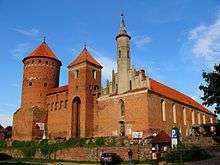
Reszel is also left over an old railway track, but E11 soon turns right (South) toward the popular pilgrimage church of Święta Lipka. It offers beds in a pilgrim house and accommodation in hotels for every budget, and the company of bus loads of tourists. After this busy beehive, E11 finds the silence of a detour through forest and a long walk over an old railway track through fields to the industrial village of Smokowo. A feeder road brings the rambler to a main road with heavy traffic. This highway, followed to the right (East) ends up at the beginning of the long high street of Kętrzyn. This is mainly a flourishing modern provincial town, but it lodges some memories of the medieval past. It also harbors the last railway station before the ending of E11, about 300 km further. Ramblers who want to interrupt their walk in any township after Kętrzyn, will have to study the time tables in Polish of the regional bus services, instead of using www.Bahn.com in English. The places passed on this stretch are Reszel - 🌍 Święta Lipka (121 km) - 🌍 Pieckowo - 🌍 Smokowo - 🌍 Biedaszki - 🌍 Kętrzyn (137 km)
Near Kętrzyn was Hitler's strongest hide-away, the so-called Wolfsschanze (Wolf's Lair). As the map shows, it was a huge military complex. House No. 6 was the location of a plot by Claus von Stauffenberg and others to kill Hitler in a late stage of World War II. Once the troops of the Red Army had conquered the place, they tried to destroy it with tons of dynamite, but large ruins can still be seen and visited.
After Kętrzyn follow 🌍 Kruszewiec - 🌍 Karolewo - 🌍 Czerniki - Szaniec - 🌍 Parcz (black) - 🌍 Jankowo - 🌍 Skrzypy (red) - 🌍 Pilwa - 🌍 Radzieje (155 km) - 🌍 Łabapa - 🌍 Sztynort (black) - 🌍 Sklodowo - Kolonie Harsz - 🌍 Harsz (169 km) - 🌍 Okowizna - 🌍 Ogonki (176 km) (blue) - 🌍 Pozezdrze (182 km) - 🌍 Sapieniec - 🌍 Przytuły - 🌍 Wilkus - 🌍 Jasieńczyk - 🌍 Jasieniec (193 km) (lodgings will be found in Jeziorowski, 2 km) (green) - 🌍 Żabinka - 🌍 L. Diabla Gora - Rogonie - 🌍 L. Leśny Zakątek (210 km) - 🌍 Czerwony Dwór - L. Olszanka - 🌍 Jabłonowo - 🌍 Golubie Wężewskie - 🌍 Wilkasy - 🌍 Kamionki - 🌍 Pietrasze - 🌍 Suczki - 🌍 Osiedłe - 🌍 Gołdap (243 km).
Gołdap - Lithuanian border (144 km)
In Gołdap, E11 offers a choice between a trail marked white-green-white that comes very close to the Russian border, or a white-red-white trail along the main road to the East. Both trails meet again after 31 km in Stanczyki. The green trail passes through uninhabited woodland and should not be recommended to ramblers with a weak sense of orientation, or those who fear Russian red tape when crossing the border unintentionally and without visa. That one reaches the Russian border before Lithuania, may be surprising to those who are not aware that Russia has an exclave around Kaliningrad, formerly German Königsberg.
For this section, the rambler will need maps N-34-69/70 and N-34-71/7. Map N-34-57/58 is only needed (badly!) for the green trail along the Russian border, Gołdap (green) - 🌍 Botkuny - 🌍 Jurkiszky - Hajnówek - 🌍 Blędziski - 🌍 Stanczyki (31 km). The red alternative is Gołdap (red) - L. Kumiacie - Botkuny - Jurkiszki - Galwiecje (12 km) - Pluszkiejmy - Budwiecie - Stańczyki (31 km).
From Stańczyki the routing is: Stańczyki (red) - 🌍 Maciejowieta (32 km from Gołdap) - 🌍 Pobłędzie - 🌍 Rakówek (yellow) - 🌍 Kłajpedka - 🌍 Kłajpeda - 🌍 Dziadówek (red) - 🌍 Dzierwany (blue) - 🌍 Smolniki (50 km) (green) - 🌍 Łopuchowon - 🌍 Udziejek - 🌍 Czajewszczyzna (58 km) - 🌍 Kazimierówka - 🌍 Jeleniewo (62 km) - 🌍 Krzemianka (64 km) - crossing with main road #8 (= E 67) in 🌍 Swajcaria (black) - 🌍 Stare Folwark (88 km) (green) - 🌍 Magdalenowo - 🌍 Czerwony Folwark - 🌍 Rosochaty Rog - Węgzał (blue) - 🌍 Maćkowa Ruda - 🌍 Wysoki Most (bridge) - 🌍 Jeziorki - 🌍 Karolin - 🌍 Wiersnie - 🌍 Giby (116 km) (lodgings in Sejny at 7 km) (red) - 🌍 Zelwa - 🌍 Berżniki - 🌍 Dworczysko - J.Szłabinki (136 km) (lodgings in Sejny, 5 km further on the red trail) (black) - 🌍 Ogrodniki border station (144 km).
Go next
E11 ends at the Polish-Lithuanian border post at 3 km from Ogrodniki. The nearest lodgings are in Sejny, 11 km along the main road, or 13 km by following the black trail back and then the red trail to the right. Those who venture into Lithuania may find a guesthouse in Lazdijaj. Neither towns has any train connection; to take a train home or to an airport, one may follow the red trail from Sejny over 25 km to the railway station of Trakiszki near Puńsk. There are also railway stations in the Polish city of Suwałki and the Lithuanian city of Sestokai. Be prepared for a long wait; there seems to be only one train in either direction from these places except Suwałki, which offers three trains daily to Białystok. You may check the most recent time tables at Bahn.com.
Via Baltica may also be an alternative. From Sejny, there's a road (651) northwest to Szypliski on highway 8, which is part of Via Baltica, alternatively you can cross over to the Lithuanian side, walk to Lazdijai and northwest along local roads 134 and 131 to Kalvarija and join the road there. While this itinerary is mainly for drivers and you probably didn't bring a car along on your hike, it's still possible to walk next to the highways. Biking is theoretically possible too, albeit more hazardous. About 800 km and three Baltic countries later, you'll be in Tallinn.